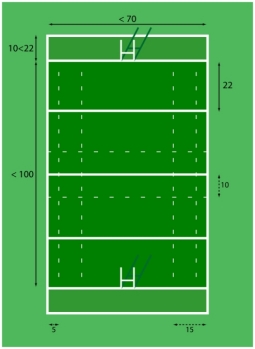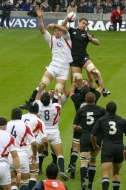By Derek Rosenfeld
 |
| An Italian League rugby ball. |
The game originated in Rugby, Warwickshire, England, at Rugby School (a coeducational day and boarding school) when, supposedly, student William Webb Ellis picked up and ran with the ball while playing football (soccer) in 1823. This claim was never substantiated, and is most likely just a legend similar to the myth that Abner Doubleday invented baseball. However, a statue of Webb stands at the Rugby School to this day, as does a plaque honoring the creation of the game, and the winner of the Rugby World Cup is awarded the William Webb Ellis Cup. In 1845, Rugby School created what is considered the first set of rugby rules.
To the average American viewer, rugby looks to be nothing more than a match between two teams playing a game of “kill the guy with the ball.” Players race around on a grid that is larger than a football field; passing around a larger, rounder version of a football and randomly kicking it in some nondescript direction; and dog-piling on one another in an effort to take the football away to run with it in the other direction. Occasionally, you see the two teams connect and struggle against each other in some weird huddle in the middle of the field.
Such first impressions have made rugby difficult for many notoriously fickle American sports fans to embrace, especially considering that it is near the bottom of the sports hierarchy in most countries in the Western Hemisphere. However, there is a small but slavishly devoted cult of rugby devotees scattered throughout this and other countries that make up an impressive number of local amateur and club rugby leagues. Many Americans might also be surprised to find out that there is a large number of men’s AND women’s collegiate rugby teams. In March 2011, USA Rugby, the governing body for rugby in the United States and an official member of the United States Olympic Committee (USOC), and the International Rugby Board (IRB), created the “Men’s Division 1A,” a 26-team, four-conference collegiate league which features the best men’s college rugby programs in the nation such as UCLA, Rutgers, Army, and Ohio State. Another fact that may surprise Americans is that the United States actually won the gold medal in rugby at both the 1920 and 1924 Olympic Games.
Dan Sandin, a resident of Montclair, New Jersey, and a member of the New York—Metropolitan Rugby Union, says, “For something that’s as hard and pounding as rugby, what I never realized is how important tactics are to the game. Once you can see what’s happening on the field, the hits are almost secondary; awesome, but secondary.”
THE PITCH AND THE PLAYERS
There are two types of rugby matches: union and sevens. For this article, I will focus on rugby union because it is more commonly played than “sevens,” so called because it uses seven players per team on the field to union’s 15 (with up to seven substitutions allowed per match). Figure 1 shows the layout of the field, or “pitch,” as being similar to a soccer and (American) football field. It can be up to 100 meters (330 feet) long and 70 meters (230 feet) wide and has goal posts on each goal line. Figure 2 shows the common setup and positions of players on the field. A team consists of eight forwards and seven backs.
| FIGURE 1. The Pitch | FIGURE 2. Player Formation |
 |
 |
THE KICK-OFF
For the average American sports fan, rugby can be thought of as a hybrid of soccer and American football; you will notice that each rule described in this article either directly or indirectly resembles a well-known rule in either sport. Each “match” lasts approximately 80 minutes (two 40-minute halves) and, as in soccer, can continue past this time period to account for injuries and other time stoppages. Three referees (one field ref and two assistant “touch judges”) officiate the match. A match officially begins when one team drop-kicks the ball from the center of the field to the other team. The ball must travel at least 10 meters for play to begin. Any of the 15 players on each team can field the ball and run with it toward the opposing team’s goal line. Crossing the line with the ball results in five points. There are several options on the positioning and distance of the initial kick-off, which yields different results for each side.
Once the receiving team fields the kick-off, it’s off to the races, as the team member with the ball advances toward the opposing team’s goal line in front of his blockers while the other team attempts to tackle him to the ground to get the ball back. When a defense begins bearing down on the ball carrier, he can pass the ball, either backwards or laterally ONLY, to one of his teammates, who attempts to continue toward the opponent’s goal line; no forward passes are allowed. You can execute a variety of kicks during a match, but when you do this, you lose control of the ball, and it is now up for grabs to either team. If the ball goes out of bounds, or “into touch,” or if play is stopped because of a penalty or violation, the game is restarted with one of rugby’s “set pieces,” which follow.
 THE SCRUM
THE SCRUM
One of the more distinctive features of rugby, as well as one of its most well-known aspects to American viewers, is the scrum. There are certain infractions during a game, such as a forward pass, which lead to a restart of play by this method. The scrum features eight players from each team binding together; the ball is then tossed in the tunnel between the teams as each attempts to regain control of it using only their feet. The scrum takes place approximately 20 meters in bounds from the spot of the infraction. Teams can be penalized for intentionally causing the scrum to collapse or for not placing the ball into the scrum correctly.

THE LINE-OUT
Similar to a throw-in in soccer, a ball that leaves the field of play by normal means (except by penalty kick) is put back into play through a “line-out.” At least two players from each team form parallel lines between five and 15 meters from the sideline area where the ball went out of bounds. (The team throwing the ball back in decides the number of players in the line-out; the opposing team cannot have more, but can have less). A player from the throwing team (usually the hooker) throws the ball on a fly toward and between the two lines. A designated player, the “jumper,” prepares to be lifted by one of his teammates in an effort to catch and secure the ball for his team. The supporting player who helps lift the jumper cannot do so until the jumper has left the ground. However, this rule is rarely, if ever, enforced.
Teams also can create a “line-out code” to signal to teammates what to do with the ball if and when it is secured. A player from the throwing team is designated to shout the code to his teammates; this type of strategy is important when advancing the ball after the throw and can catch the opposing team off guard.
In Part II, we’ll look at formations, scoring, and feature pictures from this past summer’s annual FDNY/NYPD Engeldrum/McNaughton Memorial Rugby Game, which took place at Randall’s Island in Manhattan.
Images found on Wikimedia Commons courtesy of, from top to bottom, Léna, Monnezzaro, Vijinn, Beno1000, Zegreg63, and England Kath.
 Derek Rosenfeld is an associate editor for Fire Engineering. He is the head baseball coach at Bergen Community College in Paramus, New Jersey, where he worked as an assistant coach from 2005-2011. He has also been an infielder in several highly competetive semipro baseball leagues throughout the tri-state area. During the mid-90s, Rosenfeld was a three-year starter at second base for the Ramapo College baseball team in Mahwah, New Jersey, where he earned all-New Jersey Athletic Conference honors and was a two-time New Jersey Collegiate Baseball Association (NJCBA) all-star selection. He was named MVP of the 1997 NJCBA All-Star Game. He has a bachelor’s degree in communications from Ramapo College.
Derek Rosenfeld is an associate editor for Fire Engineering. He is the head baseball coach at Bergen Community College in Paramus, New Jersey, where he worked as an assistant coach from 2005-2011. He has also been an infielder in several highly competetive semipro baseball leagues throughout the tri-state area. During the mid-90s, Rosenfeld was a three-year starter at second base for the Ramapo College baseball team in Mahwah, New Jersey, where he earned all-New Jersey Athletic Conference honors and was a two-time New Jersey Collegiate Baseball Association (NJCBA) all-star selection. He was named MVP of the 1997 NJCBA All-Star Game. He has a bachelor’s degree in communications from Ramapo College.


